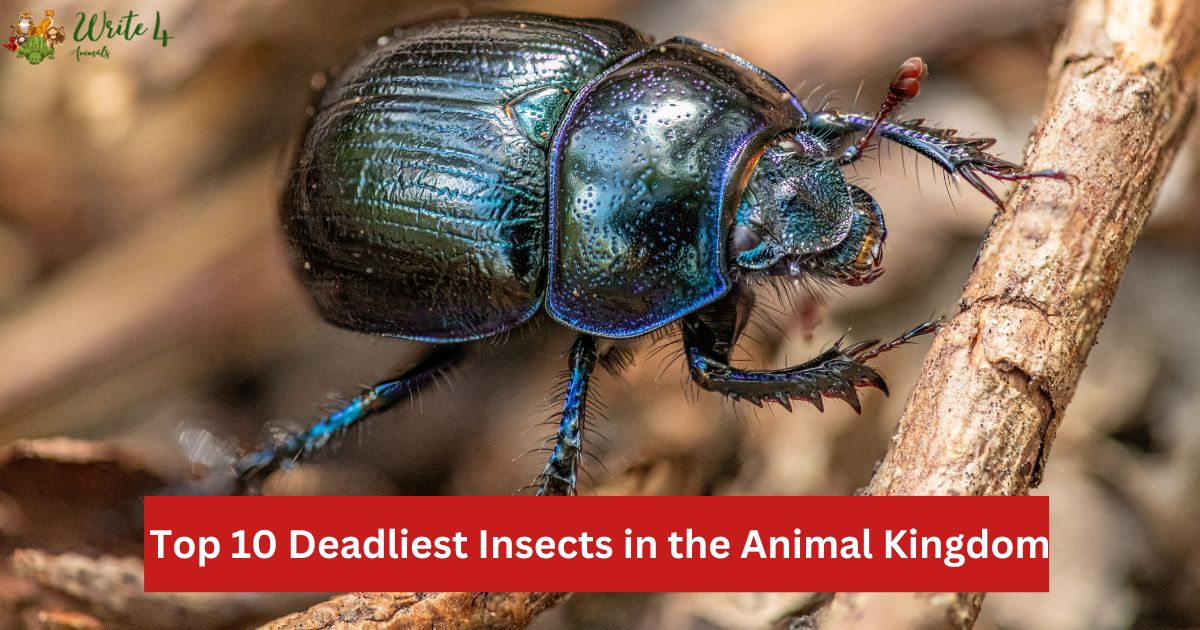Insects are the most diverse group of animals on Earth, with millions of species adapted to every conceivable habitat. While many insects are harmless or even beneficial to humans, some pose significant threats due to their venom, aggressive behavior, or the diseases they can transmit.
Here, we delve into the top 10 deadliest insects in the animal kingdom, each with its unique way of becoming a formidable foe.
Top 10 Deadliest Insects in the Animal Kingdom
1. Mosquito (Anopheles, Aedes, and Culex species)
Mosquitoes are arguably the deadliest insects in the world, responsible for more human deaths than any other creature. The danger lies not in their bite, but in the diseases they transmit. Anopheles mosquitoes are vectors for malaria, which claims hundreds of thousands of lives annually.
Aedes mosquitoes spread dengue fever, Zika virus, and chikungunya, while Culex mosquitoes can transmit West Nile virus. Despite their small size, mosquitoes have a global impact on human health.
2. Tsetse Fly (Glossina species)
The tsetse fly is a blood-feeding insect found in sub-Saharan Africa. Its bite transmits trypanosomes, the parasitic protozoa responsible for African sleeping sickness (trypanosomiasis). This disease affects humans and animals, causing fever, headaches, and joint pains, followed by neurological symptoms and, if untreated, death.
Efforts to control tsetse fly populations and treat infected individuals are ongoing, but the fly remains a significant threat in affected regions.
3. Kissing Bug (Triatominae subfamily)
Kissing bugs, also known as assassin bugs, are carriers of Trypanosoma cruzi, the parasite that causes Chagas disease. These nocturnal insects bite humans around the mouth or eyes, leaving feces that can contaminate the wound and transmit the parasite.
Chagas disease can lead to severe cardiac and digestive problems and is a major public health issue in Latin America. Millions are at risk, and the disease can be fatal if not treated.
4. Asian Giant Hornet (Vespa mandarinia)
The Asian giant hornet, often dubbed the “murder hornet,” is the world’s largest hornet, native to East Asia but recently spotted in North America. Its sting is excruciatingly painful and can deliver a potent venom that destroys tissue and, in some cases, causes anaphylactic shock.
Multiple stings can be fatal, particularly to those with allergies. Beyond their threat to humans, Asian giant hornets pose a severe risk to honeybee populations, which are vital for pollination.
5. Driver Ant (Dorylus species)
Driver ants, also known as army ants, are known for their aggressive foraging behavior and massive colonies, which can include millions of individuals. These ants are primarily found in Africa and are known to consume anything in their path, including larger animals if they are immobile.
Their powerful mandibles can cause significant injury to humans and animals alike. Swarms of driver ants are known to invade homes, causing panic and destruction in their wake.
6. Bullet Ant (Paraponera clavata)
The bullet ant is infamous for having one of the most painful stings in the insect world. Found in the rainforests of Central and South America, its sting is described as being shot by a bullet, hence its name.
The intense pain can last for 24 hours, causing temporary paralysis and severe discomfort. While not typically fatal, the bullet ant’s sting is a rite of passage in some indigenous cultures, demonstrating its significant impact.
7. Africanized Honey Bee (Apis mellifera scutellata)
Also known as “killer bees,” Africanized honey bees are a hybrid of the African honey bee and various European honey bees. They are extremely aggressive and can swarm in large numbers when threatened.
Their venom is not more potent than that of regular honey bees, but their tendency to attack in greater numbers makes them particularly dangerous. Multiple stings can result in serious injury or death, especially to those who are allergic.
8. Japanese Giant Hornet (Vespa mandarinia japonica)
The Japanese giant hornet is a subspecies of the Asian giant hornet, with similar characteristics. It delivers a potent venom through its sting, which can cause tissue damage, severe pain, and in some cases, death.
In Japan, these hornets kill dozens of people each year. Their aggressive nature and powerful sting make them a formidable threat, especially during the late summer and early autumn when they are most active.
9. Botfly (Dermatobia hominis)
The human botfly is notorious for its parasitic larvae, which burrow into the skin of mammals, including humans. The larvae grow beneath the skin, causing painful swellings and infections.
While botflies do not transmit diseases directly, the wounds they create can become infected with other pathogens. Removing botfly larvae is a painful and often difficult process, making these insects particularly dreaded in tropical regions of Central and South America.
10. Flea (Siphonaptera order)
Fleas are small, wingless insects that feed on the blood of mammals and birds. They are notorious for their role in transmitting the plague, particularly during the Black Death in the 14th century, which killed millions.
Today, fleas can still transmit diseases such as murine typhus and cat scratch fever. Their bites cause itchy, irritating sores, and heavy infestations can lead to significant discomfort and secondary infections.
Conclusion
Insects may be small, but their impact on human health and safety can be immense. From disease transmission to painful stings, these ten insects demonstrate that danger often comes in small packages.
Understanding and respecting these creatures, while taking appropriate precautions, can help mitigate their threats and ensure that we can coexist safely with the diverse and fascinating world of insects.
